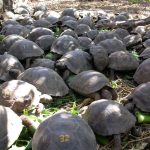 Biodiversity conservation strategies are most effective when directed towards protecting populations and ameliorating threats within their native habitat (i.e. in situ). Yet, in situ strategies may not be sufficient in all cases, requiring the management of populations outside of their native range (i.e. ex situ) using tools such as captive breeding, repatriation and/or head-starting. In the most extreme cases, where species are extinct in the wild and only persist in captivity, ex situ management may represent the only viable strategy for preventing their complete loss. Work in the ECGL uses genetic, genomic and epigenomic information to test theory underlying conventional ex situ population management and to refine strategies for maximizing founder genetic variation, equalizing founder contribution to the population’s gene pool, and minimizing fitness consequences for meeting conservation program goals. Study systems in this research area include Galápagos tortoises, Amur tigers, Lowland tapirs and Amazon parrots.
Biodiversity conservation strategies are most effective when directed towards protecting populations and ameliorating threats within their native habitat (i.e. in situ). Yet, in situ strategies may not be sufficient in all cases, requiring the management of populations outside of their native range (i.e. ex situ) using tools such as captive breeding, repatriation and/or head-starting. In the most extreme cases, where species are extinct in the wild and only persist in captivity, ex situ management may represent the only viable strategy for preventing their complete loss. Work in the ECGL uses genetic, genomic and epigenomic information to test theory underlying conventional ex situ population management and to refine strategies for maximizing founder genetic variation, equalizing founder contribution to the population’s gene pool, and minimizing fitness consequences for meeting conservation program goals. Study systems in this research area include Galápagos tortoises, Amur tigers, Lowland tapirs and Amazon parrots.

 Follow
Follow